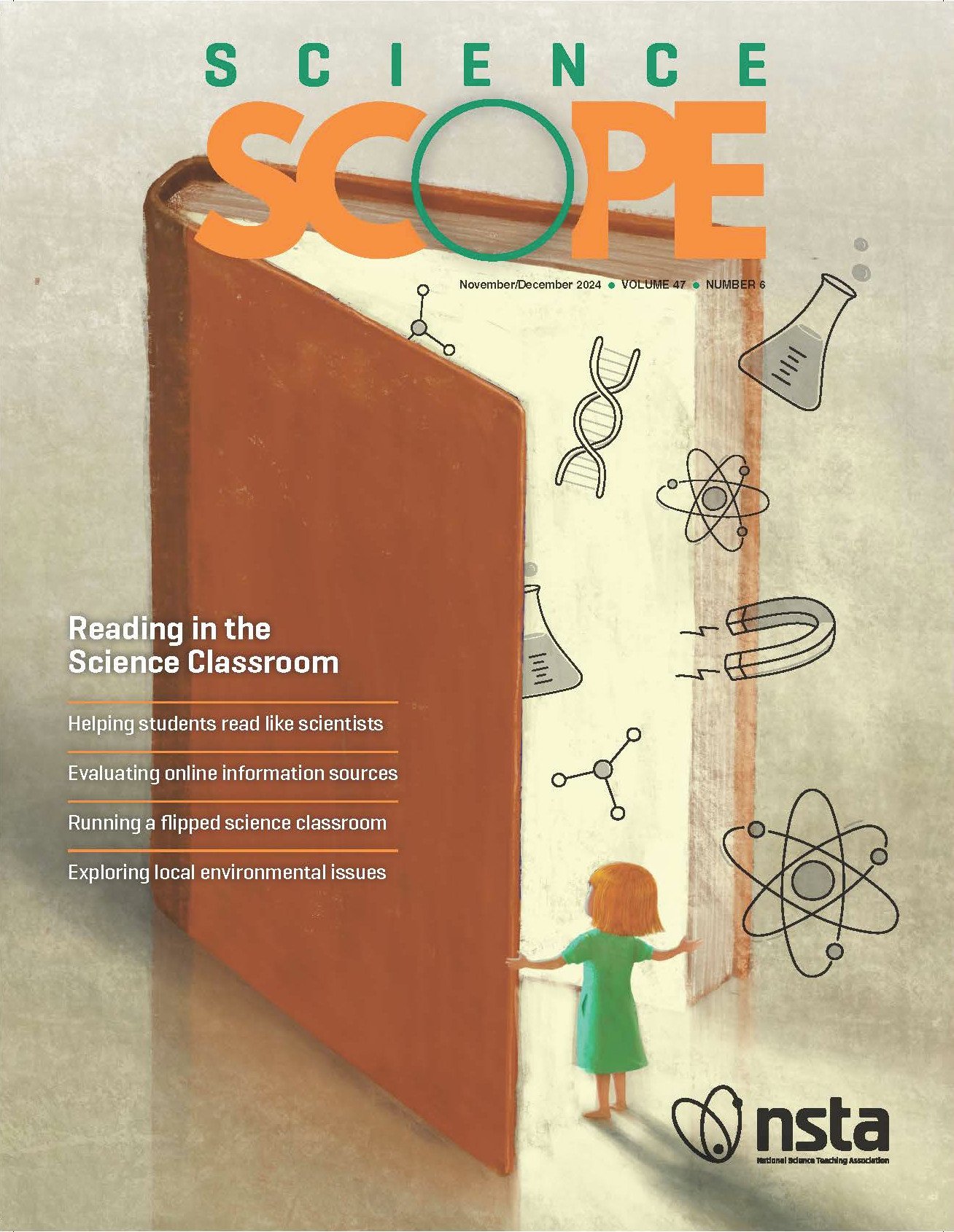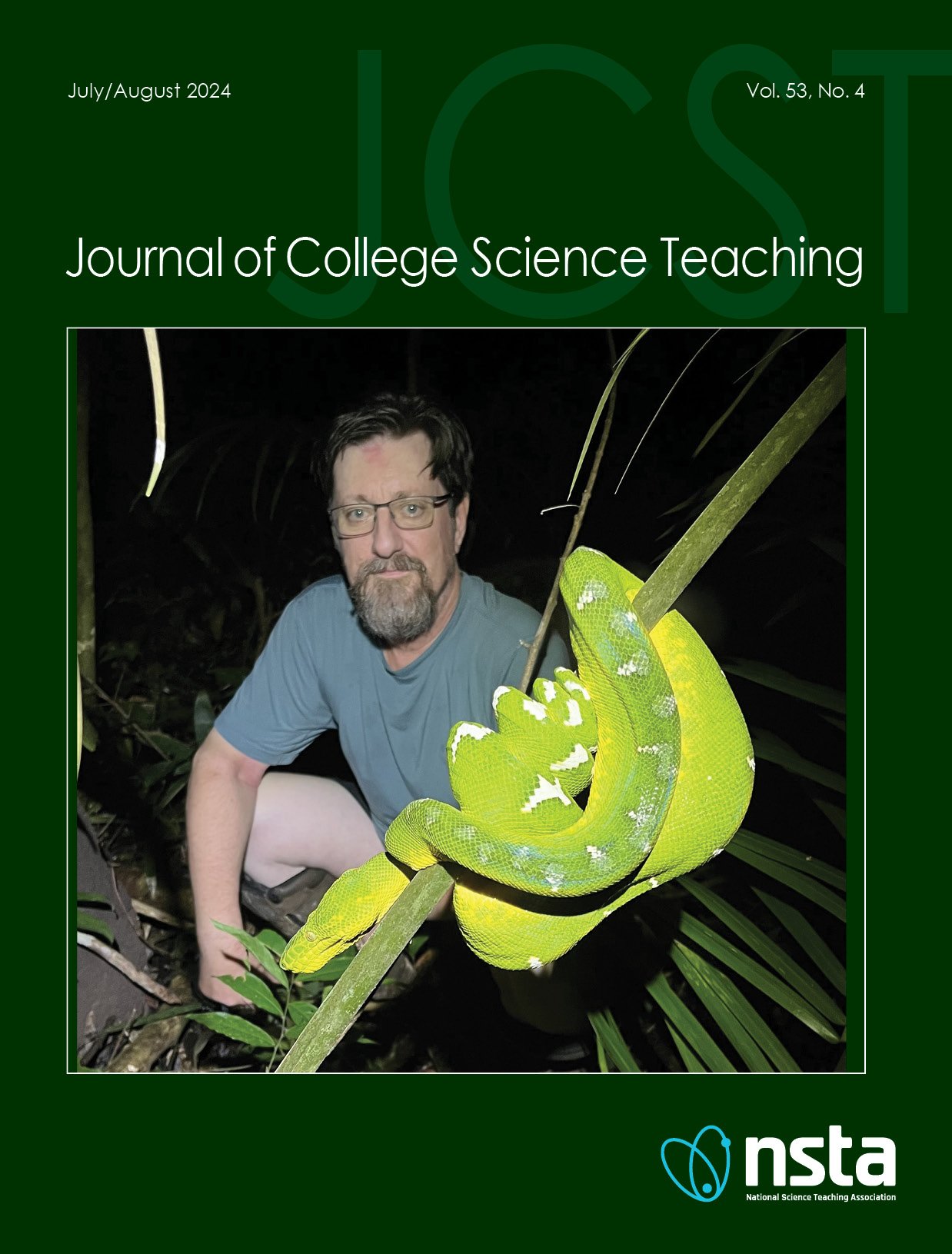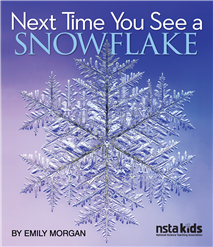All Resources
Journal Article
Establishing a Writing Center and Why Science Teachers Need to Be in On It
To support the development of scientific literacy and student confidence in expressing their ideas and receiving feedback, the first author established a writing center in a large urban fringe high school. Using the peer-assisted learning (PAL) model...
By Althea Roy, Brooke Whitworth
Journal Article
Differentiation and Inclusivity for All
Editor's Corner Novermber/December 2024...
By Brooke Whitworth
Journal Article
Career of the Month November/December 2024...
By Luba Vangelova
Journal Article
Right to the Source November/December 2024...
By Michael Apfeldorf
Journal Article
Fact or Faux? November/December 2024...
By Gábor Zemplén, DOUGLAS ALLCHIN
Journal Article
Scaffolding an Inquiry-Based Spring Constant Activity for Differentiated Physics Instruction
This activity gives students the opportunity to design an experiment, collect data, and solve for the spring constant of different springs. The use of low-cost materials and the inquiry-based structure makes it more accessible for teachers and more e...
By Eric Lindley
Journal Article
We're all in this together: Collaborative modeling tasks for the chemistry classroom
This article describes four collaborative activities that we facilitate to engage high school chemistry students in the scientific practice of developing and using models in a chemical bonding unit. The activities presented incorporate both collabora...
By Destinee Cooper, Brooke Whitworth
Journal Article
This paper describes the design and implementation of a human-centered multidisciplinary engineering course for high school students. The course was implemented and modified for both in-person and online modalities. Students worked in small groups an...
By Hoda Ehsan, Abeera Rehmat
Journal Article
Overcharging: Science of Thermal Runaway
Lithium-ion batteries solve many problems, yet also create new problems like thermal runaway. To better understand the phenomenon themselves, the authors participated in a two-day workshop about the science of thermal runaway, when lithium-ion batter...
By Amy Gilbert, Ann Dubick
Journal Article
Making Motion Meaningful: Mapping Body Movements onto Graphs
The ability to interpret graphs is foundational to understanding many science topics, although mastering this skill can prove challenging to many students. This article illustrates how a lesson on motion graphs was implemented in physical science cla...
By Rebecca Vieyra, Colleen Megowan-Romanowicz, Daniel O'Brien, Chrystian Vieyra Cortés, Mina Johnson-Glenberg
Journal Article
Using Group Roles to Promote Collaboration
Collaborating effectively in small groups is an important skill for students, especially in classrooms adopting science education reforms like the NGSS, but it is also an extremely challenging skill. In this article, I share how I use group roles as ...
By Marta Stoeckel
Journal Article
Direct experiences in the living world are a major ally in helping students understand biology and the practice of science, and in fostering a lifelong love for nature. The positive impact of field study on students’ experiences and outcomes, and t...
By Barry McPhail
Journal Article
Saving Our Water: Engagement Strategies for Designing Collaborative Community-Based Solutions
In recent years, some communities have experienced extreme conditions of drought: reduced water supply for farms, increased wildfires, and decreased water availability in reservoirs and groundwater basins. This article details how high school juniors...
By Raven Mangiante, Elaine Silva Mangiante
Journal Article
Powerful Practices for the Differentiated Science Classroom
At its core, differentiation stems from the recognition that individual learners arrive in classrooms, each day, with a wide range of knowledge, lived experiences, abilities, ways of thinking, curiosities, and dispositions. Differentiation challenges...
By Brooke Whitworth, Amy Snead
Journal Article
This study aims to contribute to the growing body of research on the role of crosscutting concepts (CCCs) in three-dimensional (3D) teaching and learning by examining the complexity of elementary preservice teachers’ (PSTs) knowledge for teaching r...
By Soon Lee, Anna Arias
Journal Article
Impact of the Timing of Content Introduction on Student Exam Performance in General Chemistry
Students come into the classroom with a variety of background knowledge. Therefore, it is imperative that educators are able to help all students, regardless of their familiarity with the content. Since it can be challenging for some large enrollment...
By Anthony Howcroft, Daniel King
Journal Article
The Connection Between Drawing Organic Structures and Information Processing
Students need a strong understanding of how to represent chemical compounds in order to succeed in organic chemistry. This project set out to gain a better understanding of students’ difficulties with symbolic representations, by identifying the sp...
By Suzanne Ruder, Courtney Stanford, Nuha Farhat, Leslie Bolda
Journal Article
Science Learning in YouTube Comments on Science Videos Embedding Movie References
Movies have long been used for teaching in undergraduate science courses. However, embedding movie references (EMR) in science videos is a new trend. This study explored how EMR in YouTube science videos might affect the nature of comments and the pr...
By Chung Man Lee, Eric Meyers, Marina Milner-Bolotin
Journal Article
Increased Student Employment is Associated with Inferior Biology Exam and Course Performance
Rising tuition rates across colleges and universities contribute to the mounting financial strain on students. In response to rising costs, literature details that students would seek to bolster their financial security by working additional hours pe...
By Finley Sims, Megan O'Connor, Jana Weber, Keenan Hartert
Journal Article
A Model for International Summer Research Experiences for STEM Students
In this article, we report on a National Science Foundation-funded immersive international summer research program for biology students. Six students, representing Cohort 1 of a three-year program, spent nine weeks at one of three institutes in Japan...
By Mika Munakata, Su San Lim, Carlos Molina
Journal Article
Effect of voluntary clicker participation on General Chemistry performance
Mixed results have been reported on the correlation between clickers and performance. This study investigates the usage of clickers in a voluntary context. Scores on an internal chemistry placement exam were used to estimate cognitive ability, as a f...
By Rayza Rosa Tavares Rodrigues, Daniel King
Journal Article
Increased Pre-Lecture Reading and Greater Attendance at a Community College Gateway Science Course
Gateway science courses are an ongoing obstacle to recruitment into STEM fields (Science, Technology, Engineering, and Mathematics). Students come to these courses with a high cognitive load, making success in the course challenging. Instructional de...
By Daniel Gertner, Allie Brashears, Na Xu, Holly Porter-Morgan
Journal Article
Evidence-based pedagogies to improve STEM student success are now recognized, but their successful incorporation can be hampered by STEM faculty wariness of novel pedagogical research. To support these pedagogies’ effective implementation, a resear...
By Nisaa Kirtman, Cary Smith, Teresa Demeritte, Debra Divinity, Vida Amouzandeh, Jo Anne Fordham, Mehri Fadavi
Journal Article
As introductory college science courses transition from large, passive lectures to more student-centered active learning environments, additional instructional support may be needed. Peer Learning Assistants (PLAs) can aid course transformations by h...
By Brittney Ferrari, Peyton LaBonte, Julie Kittleson
Journal Article
Developing Critical Thinking in Biology Through Progressive Writing Assignments
Critical thinking is essential in academia and the workforce. Although writing can be used as a pedagogical tool for fostering deeper subject matter understanding, increased retention, and critical thinking, relatively few science courses are writing...
By Irene Guttilla Reed, Michelle Kraczkowski, Steven Pearlman
Journal Article
Differences in perception of peer interactions in student-centered STEM courses
A study was done at a mid-sized public university in the Midwest of the United States. At this university, there are three large classes taught in Student-Centered Active Learning Environment with Upside-down Pedagogies (SCALE-UP) classrooms: algebra...
By Alison Page, Jennifer Blue
Journal Article
A Partnership to Support Improved Public Understandings of Science Education
Although public attitudes towards K-12 education are relatively positive, there are still fundamental misunderstandings about what effective science teaching entails, which could hinder public support for science education. This article describes a p...
By Julianne Wenner, Sarah Lausch, Megan Frary, Paul Simmonds
Journal Article
Engaging Middle School Students with the Nature of Particles, Waves, and Light
This three-day unit engages students in the exploration of light behavior and makes connections to the advanced idea of the wave-particle duality of light. Students begin by exploring the behaviors of marbles (particles) as they interact with differe...
By Isaiah Kent-Schneider, Jerrid Kruse, Dan Chibnall, Paige Anderson, Emma Richards, Brooke Christenson
Journal Article
My Students Read Like Scientists. Now Yours Can, Too!
While hands-on activities are important in science, students must have the opportunity to process the ideas and information that stem from those activities. Minds-on science activities, such as literacy integration, support making connections between...
By Mesa Davis, Kadir Demir
Journal Article
Reading in the Science Classroom
From the Editor's Desk, November/December 2024...
By Patricia McGinnis
Journal Article
This phenomenon-driven unit focuses on students making sense of the mutually beneficial species interactions between legumes and rhizobia. Many science classes spend less time studying the nitrogen cycle due to time constraints and more focus on othe...
By Kerrie Rovito, Lara Smetana, Michael Grillo, Alyssa Hoffman, Sydney DelGhingaro
Journal Article
Journey of the Monarchs: Studying North America’s Nomadic Butterfly
Citizen Science November/December 2024...
By Jill Nugent
Journal Article
One of the most cost-effective ways to engage students in real-world STEM is by turning to local issues of emerging relevance through current events. In this middle school lesson, local current STEM events are used to encourage students to explore th...
By Rebecca Grella
Journal Article
Flipped Science Classrooms and the Cornell Note-Taking Method
The flipped classroom is a relatively new innovation in teaching middle school science; however, students often struggle with taking notes that provide metacognitive cues and reinforce understanding. This paper describes the structure of a flipped mi...
By Edward Miller, Angela Kelly
Journal Article
Many young people learn about scientific topics online, yet middle school students have trouble identifying where scientific information comes from and what characterizes good sources of scientific information online. In this article, we discuss five...
By Sara Montgomery, Angela Kohnen, Christine Wusylko
NSTA Kids
Click here to view video of Next Time You See a Snowflake This book will have you seeing snowflakes in a whole new way. You’ll learn about the science of snowflakes – how they form, why they are six-sided, what conditions are necessary for the...
NSTA Kids
Next Time You See a Snowflake (Hardcover)
Click here to view video of Next Time You See a Snowflake This book will have you seeing snowflakes in a whole new way. You’ll learn about the science of snowflakes – how they form, why they are six-sided, what conditions are necessary for the...






